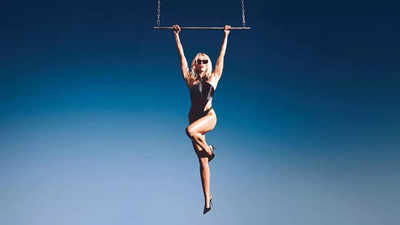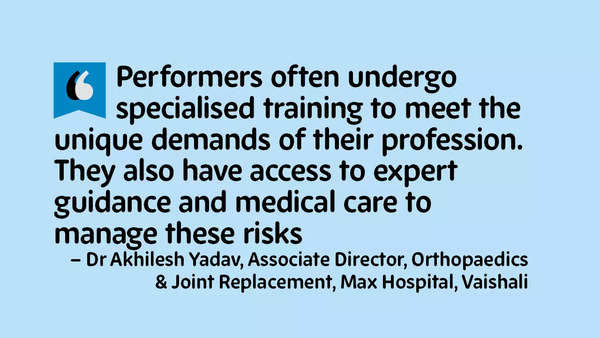- News
- lifestyle
- health-fitness
- fitness
- Miley Cyrus says she trains in heels – but you shouldn’t
Trending
Miley Cyrus says she trains in heels – but you shouldn’t
Workout in heels like Miley is definitely not recommended by experts and if you twist and turn wearing heels in your workout space, you’ll probably end up with injuries

Miley Cyrus says she trains in heels
Miley Cyrus in a recent interview to W Magazine said that she is “interested in feminising the workout space, because so much of the workout equipment is ugly... My mantra is, like any athlete, ‘Practice how you perform.’ So that’s why I practice in my heels. The gym looks really tough, but then I’ve got my ivory Gucci slingbacks because they remind me of Marilyn Monroe.I train in heels, mostly.”
From Beyonce in Single Ladies and Crazy in Love to Jennifer Lopez in On the Floor - and probably most pop music videos in 2000s - female artistes made dancing in heels or stilettos look easy. However workout in heels like Miley is definitely not recommended by experts and if you twist and turn wearing heels in your workout space, you’ll probably end up with injuries.

Thinking what might possibly go wrong? Everything, say experts
Ankle injuries: Heels elevate the heel and shift the center of gravity forward, making it easier to twist or sprain an ankle during movements
Balance issues: The narrow base of heels can compromise stability, increasing the risk of falls
Knee strain: The altered posture from wearing heels can place extra stress on the knees, potentially leading to joint issues
Foot problems: Heels can cause discomfort and pain in the feet, including issues like bunions, hammertoes, and plantar fasciitis
Spine alignment: The forward tilt from heels can disrupt natural spine alignment, leading to lower back pain
Change in posture: Heels force the body into an unnatural posture, which can lead to muscle imbalances and strain on the lower back and legs
Muscle engagement: While heels might engage certain muscles more (such as calves and thighs), they do so in a way that is not optimal for strength and conditioning. This can lead to muscle overuse or improper development
Range of motion: Heels restrict the range of motion in the ankles and feet, which can interfere with the proper execution of many exercises
Long-term effects: Regularly working out in heels can lead to chronic pain and long-term musculoskeletal issues
– Inputs by Dr V Anand Naik, Senior Consultant, Spine Surgery, PSRI Hospital

‘Not advisable for the average person’
While Miley may benefit from practicing in heels, for most of us who cannot even walk too long in high heels, this is unimaginable. Imagine trying to do mountain climbers in your gym with heels! Experts also say that it is not a recommended practice. “Working out in high heels or stilettos is not safe for most individuals. Yes, there are reports of performers doing workout in their heels but it is not recommended for someone engaging in any kind of exercise for leisure or fitness. There are very high chances of getting injured. Any pointed stilettos or high heels is totally not recommended for workout,” says Dr Aashish Chaudhry, Managing Director, Senior Consultant & Head, Department of Orthopaedics& Joint Replacement Aakash Healthcare.
“Exercises such as weightlifting, running, jumping, and even certain types of stretching can be particularly dangerous in heels due to the instability and lack of support they provide. Proper athletic footwear is essential for safe and effective workouts. If someone feels the need to train in heels for specific performancerelated
reasons, it should be done under professional supervision with a clear understanding of the associated risks,” points out Dr Akhilesh Yadav.
From Beyonce in Single Ladies and Crazy in Love to Jennifer Lopez in On the Floor - and probably most pop music videos in 2000s - female artistes made dancing in heels or stilettos look easy. However workout in heels like Miley is definitely not recommended by experts and if you twist and turn wearing heels in your workout space, you’ll probably end up with injuries.

Proper athletic footwear is essential for safe and effective workouts, say experts
Thinking what might possibly go wrong? Everything, say experts
Working out in heels is generally not recommended for most types of exercise due to several safety and health concerns. Here’s why it can be risky:
Ankle injuries: Heels elevate the heel and shift the center of gravity forward, making it easier to twist or sprain an ankle during movements
Balance issues: The narrow base of heels can compromise stability, increasing the risk of falls
Knee strain: The altered posture from wearing heels can place extra stress on the knees, potentially leading to joint issues
Foot problems: Heels can cause discomfort and pain in the feet, including issues like bunions, hammertoes, and plantar fasciitis
Spine alignment: The forward tilt from heels can disrupt natural spine alignment, leading to lower back pain
Change in posture: Heels force the body into an unnatural posture, which can lead to muscle imbalances and strain on the lower back and legs
Muscle engagement: While heels might engage certain muscles more (such as calves and thighs), they do so in a way that is not optimal for strength and conditioning. This can lead to muscle overuse or improper development
Range of motion: Heels restrict the range of motion in the ankles and feet, which can interfere with the proper execution of many exercises
Long-term effects: Regularly working out in heels can lead to chronic pain and long-term musculoskeletal issues
– Inputs by Dr V Anand Naik, Senior Consultant, Spine Surgery, PSRI Hospital

Dr Akhilesh Yadav, Associate Director, Orthopaedics & Joint Replacement, Max Hospital, Vaishali
‘Not advisable for the average person’
While Miley may benefit from practicing in heels, for most of us who cannot even walk too long in high heels, this is unimaginable. Imagine trying to do mountain climbers in your gym with heels! Experts also say that it is not a recommended practice. “Working out in high heels or stilettos is not safe for most individuals. Yes, there are reports of performers doing workout in their heels but it is not recommended for someone engaging in any kind of exercise for leisure or fitness. There are very high chances of getting injured. Any pointed stilettos or high heels is totally not recommended for workout,” says Dr Aashish Chaudhry, Managing Director, Senior Consultant & Head, Department of Orthopaedics& Joint Replacement Aakash Healthcare.
“Exercises such as weightlifting, running, jumping, and even certain types of stretching can be particularly dangerous in heels due to the instability and lack of support they provide. Proper athletic footwear is essential for safe and effective workouts. If someone feels the need to train in heels for specific performancerelated
reasons, it should be done under professional supervision with a clear understanding of the associated risks,” points out Dr Akhilesh Yadav.
End of Article
FOLLOW US ON SOCIAL MEDIA








